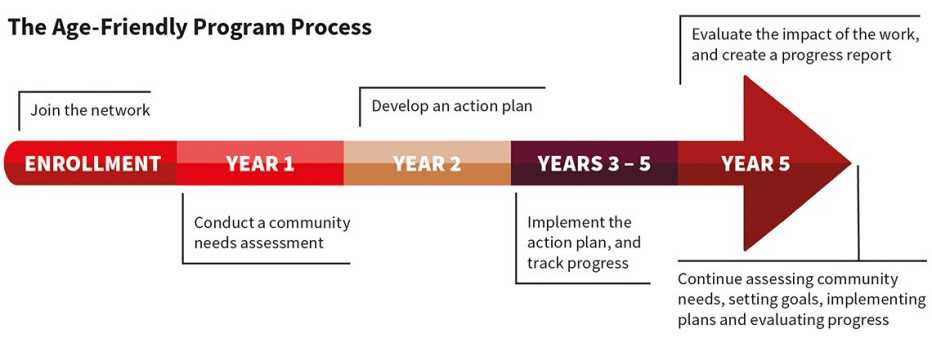AARP Hearing Center


Members of the AARP Network of Age-Friendly States and Communities commit to an assessment process and five-year cycle of continuous improvement, the steps of which typically require the member community to:
Step 1: Establish a way to include older residents in all stages of the age-friendly process
Initiate a system to incorporate older residents in all facets of the age-friendly process. This typically involves setting up advisory councils or working groups that include the diversity in your community, including different ages (or older residents). The goal is to ensure that older residents actively participate in shaping age-friendly initiatives in the community.
Step 2: Conduct a community needs assessment
Communities must carry out a community needs assessment. Utilize survey examples provided by AARP and their online survey platform. The assessment helps pinpoint community strengths and identify the crucial needs and concerns of residents, laying a foundation for targeted action.
Step 3: Develop an action and evaluation plan based on the assessment results
Communities formulate an action and evaluation plan based on the assessment results. The municipality reviews the plan before AARP approves it. Once approved, your community's Network membership extends for three more years. The plan should detail goals and strategies for identified needs. It should also include methods for tracking progress and measuring the success of the implemented initiatives.
Step 4: Implement and work toward the goals of the plan
Upon approval, communities begin implementing their age-friendly action plan. This involves working towards the goals outlined in the plan, collaborating with relevant partners, and adjusting strategies as necessary to ensure maximum effectiveness.
Step 5: Assess the impact of implementing the plan and submit progress reports
Communities should continuously evaluate the impact of their efforts and provide regular updates to partners and residents. This ongoing evaluation allows communities to refine their approaches, ensuring they stay on track towards achieving their age-friendly goals.
Step 6: Share solutions, successes and best practices across the Network
An essential part of the program cycle is sharing solutions, successes, and best practices across the network. Promote a collaborative environment where member communities can learn from each other and apply proven strategies to their own age-friendly initiatives.
Step 7: Repeat
The program cycle stresses the importance of continuous improvement and adaptation. Communities should repeat the process, incorporating lessons learned and insights gained from each cycle.
The network promotes an ongoing cycle of continuous improvement, focusing on the importance of including older residents in every stage of the process. This approach not only empowers older adults but also ensures that the solutions implemented are tailored to meet the unique needs and preferences of residents.
Page updated: February 2020



























































